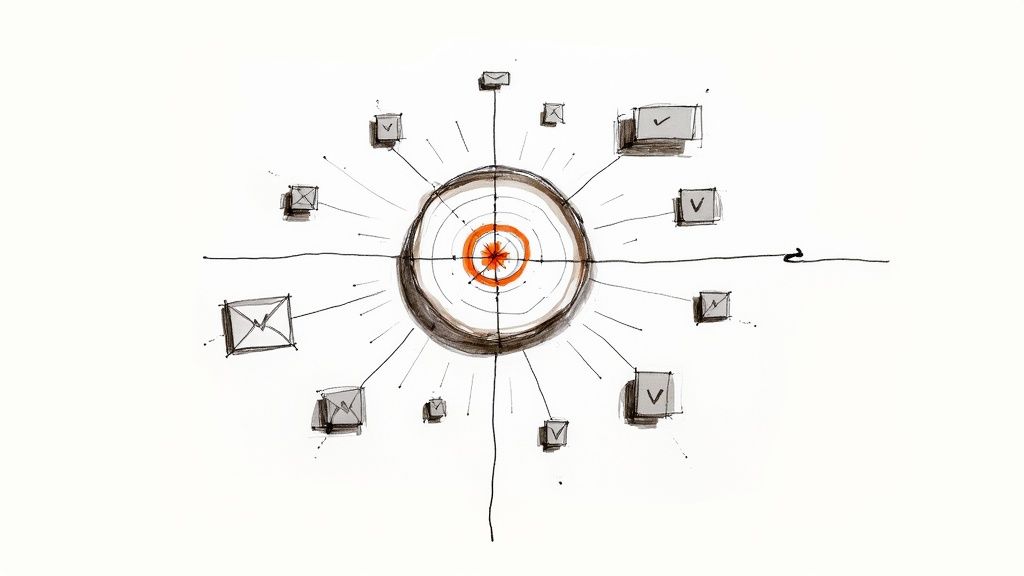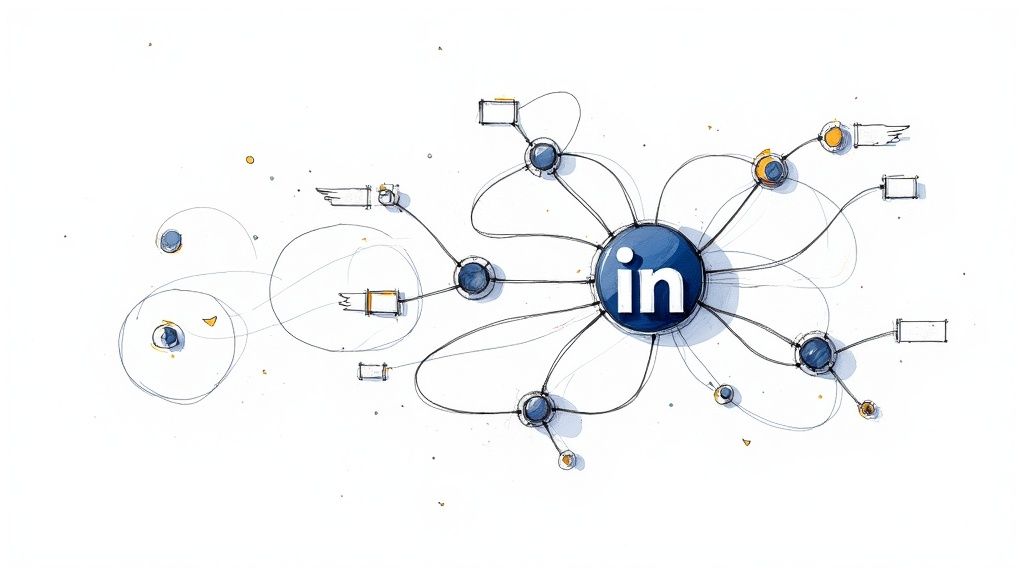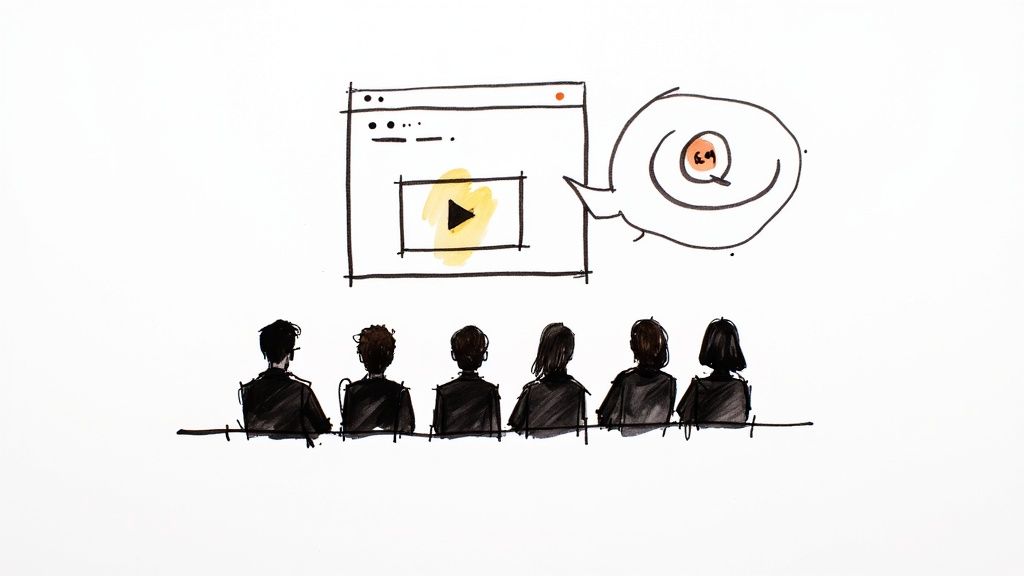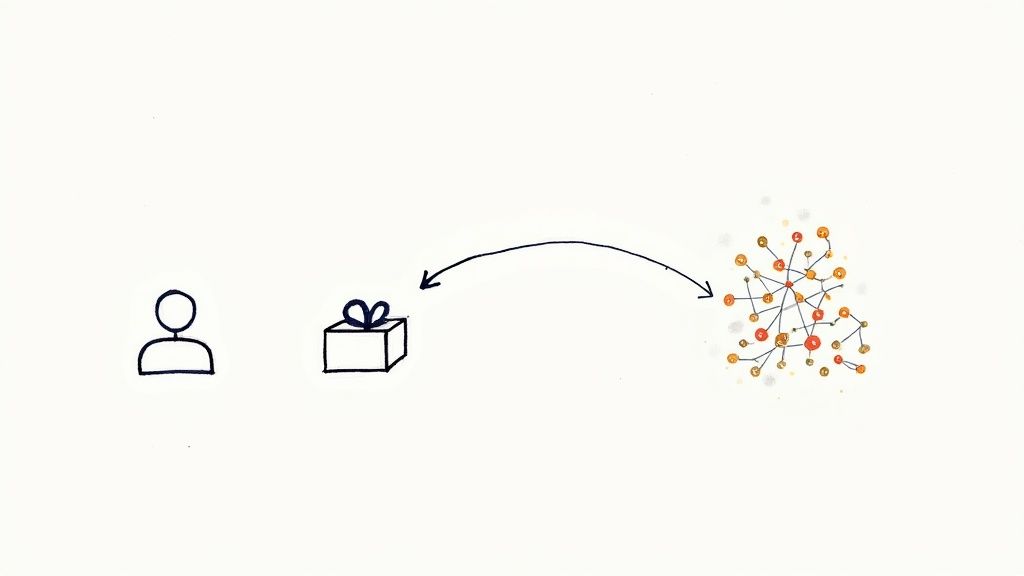In the hyper-competitive B2B landscape, acquiring new customers is more challenging and more critical than ever. The old tactics of casting a wide, impersonal net have given way to more precise, value-driven approaches. The challenge isn't just about finding leads; it's about connecting with the right decision-makers, building genuine trust, and proving your value long before a sales conversation ever begins. This requires a multi-faceted playbook that blends technology with human insight.
This guide moves beyond generic advice to dissect 10 powerful b2b customer acquisition strategies that are delivering tangible results today. We will provide actionable steps, real-world examples, and expert tips to help you build a robust and sustainable customer acquisition engine. Forget surface-level theory; this is a tactical breakdown designed for immediate application.
You will learn how to implement sophisticated methods like Account-Based Marketing (ABM) to target high-value accounts with precision, and how to leverage content to establish true thought leadership that attracts, rather than interrupts, ideal clients. We’ll also explore modern essentials such as LinkedIn social selling, strategic partnerships, and performance-driven search engine marketing. From crafting compelling cold outreach that gets replies to hosting virtual events that convert, each strategy is presented as a vital component of a comprehensive growth plan. Prepare to equip your sales and marketing teams with a fresh playbook for winning new business and driving predictable revenue.
1. Account-Based Marketing (ABM)
Account-Based Marketing (ABM) is a highly focused B2B customer acquisition strategy that inverts the traditional marketing funnel. Instead of casting a wide net to capture as many leads as possible, ABM concentrates sales and marketing resources on a carefully selected list of high-value target accounts. This approach treats individual accounts as a "market of one," allowing for deeply personalized outreach and engagement.

The core principle is quality over quantity. By aligning sales and marketing teams from the outset, companies can create unified, bespoke buying experiences for the accounts most likely to become significant customers. This laser-focused methodology is particularly effective for businesses with high-value products or services, long sales cycles, and a need to engage multiple stakeholders within a target company.
How to Implement Account-Based Marketing
Executing a successful ABM campaign requires deep coordination and a multi-channel approach. It moves beyond generic messaging to deliver content and interactions tailored specifically to an account's pain points and industry.
- Identify & Research Target Accounts: Collaborate with your sales team to create an Ideal Customer Profile (ICP). Use firmographic data (company size, industry, revenue) and intent data (online behaviors indicating buying interest) to build a small, manageable list of high-value target accounts.
- Create Personalized Content: Develop account-specific assets like case studies, white papers, or personalized landing pages that address the unique challenges of each target. For example, Snowflake created personalized content hubs for its Fortune 500 targets, resulting in significant engagement.
- Execute Coordinated Campaigns: Use a mix of channels to engage key decision-makers within the account. This could include personalized emails, targeted social media ads, direct mail, and tailored sales outreach.
- Measure & Optimize: Track metrics focused on account engagement, such as the number of stakeholders reached, meeting-to-opportunity conversion rates, and deal velocity. Adobe's ABM program, for instance, generated deal sizes two times higher than its traditional marketing efforts.
Key Insight: ABM demands a fundamental shift from lead-centric to account-centric thinking. Success hinges on the tight alignment of sales and marketing KPIs, ensuring both teams are working towards the shared goal of penetrating and winning specific, high-value accounts.
2. Content Marketing and Thought Leadership
Content Marketing and Thought Leadership is a strategic B2B customer acquisition strategy focused on creating and distributing valuable, relevant, and consistent content. The goal is to attract and retain a clearly defined audience by addressing their specific pain points and industry challenges, ultimately driving profitable customer action. In B2B, this often involves establishing company leaders as authoritative experts in their field.
Unlike direct advertising, this approach builds trust and credibility over time. By consistently providing educational and insightful material, businesses can position themselves as the go-to resource in their niche. This is particularly powerful in B2B, where purchase decisions are complex, involve multiple stakeholders, and rely heavily on trust and proven expertise. HubSpot, for example, built its entire empire by providing exceptional free content that solved marketers' problems.
How to Implement Content Marketing and Thought Leadership
Effective execution requires a deep understanding of your audience's needs and a commitment to quality over quantity. The aim is to create content that educates and empowers, not just sells. For specific strategies tailored to business audiences, refer to these proven B2B Content Marketing Best Practices.
- Focus on Solving Real Problems: Identify the most pressing questions and challenges your ideal customers face. As popularized by Marcus Sheridan's "They Ask, You Answer" philosophy, your content strategy should be built around providing the best, most honest answers to those questions.
- Create Pillar Content & Repurpose: Develop comprehensive, data-driven assets like original research reports, ultimate guides, or in-depth white papers. These "pillar" pieces can then be repurposed into smaller formats like blog posts, social media updates, infographics, and video clips to maximize reach across different channels.
- Optimize for the Buyer's Journey: Create content tailored to each stage of the funnel. Awareness-stage content might be a blog post defining an industry problem, while consideration-stage content could be a case study or a webinar demonstrating your solution.
- Measure Engagement & Lead Quality: Track metrics beyond page views. Focus on engagement rates, time on page, newsletter sign-ups, and the quality of leads generated from content downloads. Salesforce uses its Trailhead platform not only to educate users but also to identify highly engaged potential customers.
Key Insight: The most effective B2B content marketing doesn't feel like marketing at all. It establishes your brand as a generous expert and trusted advisor, making you the natural choice when a prospect is finally ready to buy.
3. LinkedIn Social Selling and Outreach
LinkedIn Social Selling is a modern sales approach that leverages the world's largest professional network to find, connect with, and nurture relationships with potential B2B customers. This strategy shifts the focus from hard selling to building trust and credibility by sharing valuable content, engaging in relevant conversations, and offering solutions to prospect pain points.

The core principle is to position sales professionals as trusted advisors rather than just vendors. By consistently providing value within their network, they can establish thought leadership and become the go-to resource when a prospect is ready to buy. This method is highly effective for B2B customer acquisition strategies because it allows for direct access to decision-makers in a professional context, making it a powerful channel for generating high-quality, qualified leads.
How to Implement LinkedIn Social Selling
A successful LinkedIn strategy requires patience and a genuine desire to help, not just sell. It’s about playing the long game by building authentic relationships that lead to business opportunities.
- Optimize Your Profile for Prospects: Treat your LinkedIn profile as a landing page. Use a professional headshot, a benefit-driven headline, and a detailed "About" section that speaks directly to your ideal customer's challenges and goals.
- Share Valuable Content Consistently: Post industry insights, thought-provoking questions, and helpful resources that resonate with your target audience. Gong's sales team, for example, shares data-backed sales tips, generating millions in pipeline by establishing deep industry expertise.
- Personalize All Outreach: Avoid generic connection requests and messages. Reference a shared connection, a recent post they engaged with, or a piece of content they published to show you’ve done your research.
- Engage Before Connecting: Like, comment on, and share your prospect's content for a period before sending a connection request. This "warm-up" makes your eventual outreach feel more natural and less transactional. For more on advanced prospecting, learn more about boosting your search performance with LinkedIn Sales Navigator.
Key Insight: Effective social selling is about "giving" before you "ask." The goal is to build social capital by becoming a known, liked, and trusted authority in your niche. When a need arises, you will be the first person your prospects think of.
4. Strategic Partnerships and Channel Marketing
Strategic Partnerships and Channel Marketing is a powerful B2B customer acquisition strategy that relies on collaboration with other companies. Instead of only pursuing customers directly, this approach involves forming alliances with complementary, non-competing businesses to leverage each other's market reach, credibility, and customer base for mutual growth.
This collaborative model accelerates growth by tapping into established trust and audiences. It can take many forms, including co-marketing campaigns, referral programs, reseller agreements, or technical integrations. HubSpot's partner ecosystem, for example, generates over 40% of its new customers, showcasing the immense potential of building a network of allies.
How to Implement Strategic Partnerships and Channel Marketing
Building a successful partnership program requires a structured approach focused on creating genuine, mutual value. The goal is to make it easy for partners to succeed while delivering a seamless experience for the end customer.
- Identify & Qualify Potential Partners: Define your Ideal Partner Profile (IPP). Look for companies whose products or services complement your own and who share a similar target audience. Tools like Crossbeam can help identify overlapping customers and prospects to find strong potential fits.
- Establish Clear Agreements: Create a formal partnership agreement that outlines roles, responsibilities, revenue sharing or referral fees, and goals. Clarity from the outset prevents future misunderstandings and ensures both parties are aligned on expectations.
- Enable Your Partners: Equip partners with the resources they need to succeed. This includes comprehensive sales training, co-branded marketing collateral, and access to dedicated support. The easier you make it for them to sell, the more they will.
- Execute Joint Initiatives: Collaborate on co-marketing activities such as webinars, blog posts, or case studies. A great example is the integration partnership between Slack and Zoom, which provides a seamless user experience and drives cross-promotion, acquiring customers for both platforms.
- Measure & Optimize: Track key partnership metrics like partner-sourced leads, revenue generated, and deal close rates. Regularly review performance with your partners to identify what’s working and where you can improve your collaborative efforts.
Key Insight: The most effective strategic partnerships are built on a "give-to-get" philosophy. Focus on providing value to your partners and their customers first. This approach builds the trust and reciprocity needed for a long-term, revenue-generating relationship.
5. Search Engine Marketing (SEM) and SEO
Search Engine Marketing (SEM) and Search Engine Optimization (SEO) are complementary digital marketing strategies designed to capture high-intent prospects by increasing visibility on search engine results pages (SERPs). SEO focuses on earning organic, unpaid traffic through content and technical site optimization, while SEM uses paid advertising (like Google Ads) to place your business in front of users actively searching for your solutions.
This powerful combination allows B2B companies to engage buyers at the exact moment they express a need. When a prospect searches for a specific problem your product solves, appearing at the top of the results, both organically and through ads, establishes immediate authority and significantly increases the likelihood of a click-through. Atlassian, for example, has built a formidable presence by targeting development-related keywords, driving millions in high-value organic B2B traffic to its product ecosystem.
How to Implement SEM and SEO
Executing a successful search strategy requires a dual-pronged approach that balances long-term organic growth with immediate paid visibility. For your content marketing efforts to truly shine and drive B2B leads, understanding and implementing essential content SEO best practices is non-negotiable.
- Focus on High-Intent Keywords: Research and target long-tail, problem-solving keywords that B2B decision-makers use. Think "supply chain management software for manufacturers" instead of just "software."
- Create Dedicated Paid Landing Pages: For each SEM campaign, direct traffic to a purpose-built landing page that matches the ad copy and has a clear call-to-action. This improves conversion rates and Google's Quality Score.
- Optimize for Organic Visibility: Develop a content strategy around your target keywords, creating high-value blog posts, guides, and tools that answer user questions. This builds long-term organic authority.
- Leverage Negative Keywords: In your paid campaigns, use negative keywords to exclude irrelevant search queries. This prevents wasted ad spend on unqualified clicks and improves lead quality.
Key Insight: The most effective B2B customer acquisition strategies don't treat SEO and SEM as separate channels. Instead, they integrate them. Use paid ads to test keywords and messaging quickly, then apply those learnings to your long-term organic SEO strategy for maximum SERP dominance.
6. Cold Email and Outbound Prospecting
Cold Email and Outbound Prospecting is a proactive B2B customer acquisition strategy focused on initiating conversations with potential customers who have not previously interacted with your brand. Far from outdated mass spamming, modern outbound prospecting relies on deep research, personalized messaging, and systematic follow-up to connect with specific decision-makers. It’s a direct line to your ideal prospects, bypassing the wait for inbound interest.
The strategy is built on the principle of delivering the right message to the right person at the right time. By identifying prospects who fit your Ideal Customer Profile (ICP), you can craft targeted outreach that speaks directly to their potential challenges and goals. This method is highly effective for B2B companies with a clear target market, enabling them to build a predictable sales pipeline, as famously outlined in Aaron Ross's "Predictable Revenue" methodology.
How to Implement Cold Email and Outbound Prospecting
A successful outbound campaign is a science, blending personalization with scalable processes. It requires a disciplined approach to building lists, crafting messages, and managing follow-ups to turn cold contacts into warm leads.
- Build a Hyper-Targeted Prospect List: Use tools like LinkedIn Sales Navigator and data providers to build a list of contacts that match your ICP. Focus on specific job titles, industries, company sizes, and even recent company news or trigger events.
- Craft a Value-First Message: Your initial email should be short, personalized, and focused on the prospect's world, not yours. Lead with a relevant insight, a compelling statistic, or a reference to their work. The goal is to start a conversation, not to make an immediate sale. Outreach.io famously used this tactic to build its initial customer base.
- Systematize Your Follow-up: Most responses come from follow-up emails, not the initial outreach. Use an automated sequence to send a series of 3-5 polite, value-added follow-ups over several weeks. Each message should offer a new piece of value or a different angle.
- Measure and Iterate: Track open rates, reply rates, and positive reply rates to understand what's working. A/B test subject lines, calls-to-action, and email copy to continuously improve performance. Companies like Lemlist used their own cold email strategies to grow to over $10M in ARR by constantly refining their approach. For a deeper dive into scaling this process, you can learn more about cold email automation.
Key Insight: Modern cold outreach is not a numbers game; it's a relevance game. The success of this B2B customer acquisition strategy hinges on your ability to prove you've done your homework and can offer genuine value before you ever ask for a minute of their time.
7. Webinars and Virtual Events
Webinars and virtual events are a cornerstone of modern B2B customer acquisition strategies, functioning as powerful educational marketing tools. This approach uses online presentations, workshops, and virtual summits to demonstrate expertise, provide immense value upfront, and generate a stream of highly qualified leads. It effectively combines thought leadership with interactive engagement, enabling companies to connect with a global audience and nurture relationships at scale.

The principle behind this strategy is to attract potential customers by offering solutions to their problems, not just by pitching a product. By delivering valuable, actionable content, businesses establish themselves as trusted authorities in their niche. This is particularly effective for B2B companies with complex products or services, as it provides a platform to educate prospects, answer questions in real-time, and guide them through the consideration phase of their buying journey.
How to Implement Webinars and Virtual Events
Executing a successful virtual event requires careful planning, robust promotion, and a clear follow-up strategy. The goal is to create a seamless and valuable experience that converts attendees into engaged leads.
- Choose Topics that Solve Real Problems: Base your webinar content on your Ideal Customer Profile's most significant pain points. Use keyword research, customer feedback, and sales team insights to select topics that promise a clear, tangible benefit. Drift’s virtual summit, for example, focused on pressing conversational marketing trends, attracting over 50,000 attendees and generating substantial pipeline.
- Promote Across Multiple Channels: Use a coordinated promotional strategy that includes email marketing to your existing list, targeted social media ads, organic social posts, and partnerships with influencers or other brands. Create a dedicated landing page that clearly outlines the value proposition of attending.
- Deliver a Flawless Experience: Practice your presentation and conduct a full technical run-through to avoid issues. Engage the audience with polls, Q&A sessions, and interactive elements. Always provide valuable takeaways, such as a slide deck, a checklist, or an exclusive resource.
- Follow Up Strategically: Segment your follow-up communication. Send a recording and thank-you note to attendees, and a separate "sorry we missed you" email with the recording to no-shows. Use this as an opportunity to share relevant content or offer a personalized demo.
Key Insight: The success of a webinar isn't measured by registration numbers alone, but by the quality of engagement and the effectiveness of the post-event nurture sequence. Treat your webinar as the beginning of a conversation, not a one-off presentation, to transform attendees into loyal customers.
8. Customer Referral Programs
Customer Referral Programs offer one of the most powerful and cost-effective B2B customer acquisition strategies by systematically encouraging satisfied clients to advocate on your behalf. This approach leverages the immense power of word-of-mouth marketing, turning your happiest customers into a proactive, high-trust sales force. It capitalizes on the credibility and pre-existing relationships within professional networks, leading to warmer introductions and significantly higher conversion rates than traditional cold outreach.

The underlying principle is that a recommendation from a trusted peer is more persuasive than any marketing message. By formalizing this process with clear incentives, you can accelerate growth and acquire customers who are often a better fit and have a higher lifetime value. This strategy is particularly effective for B2B companies with a strong product and high customer satisfaction, as it transforms positive sentiment into tangible business growth.
How to Implement Customer Referral Programs
A successful referral program is built on simplicity, valuable incentives, and strategic timing. It should be effortless for customers to participate and feel rewarding for both the referrer and the new client they bring in.
- Make the Process Simple & Intuitive: Reduce friction by providing pre-written email templates, a dedicated referral portal, or unique sharing links. The easier it is for a customer to refer someone, the more likely they are to do it. Platforms like ReferralCandy or Extole can automate and simplify this entire workflow.
- Provide Valuable, Two-Sided Incentives: Reward both the referrer for their effort and the new customer for signing up. B2B incentives can include service credits, gift cards, exclusive feature access, or even cash bonuses. Tesla famously used this model to generate thousands of vehicle sales through customer-driven advocacy.
- Time Your Referral Asks Strategically: Request referrals when customer satisfaction is at its peak, such as after a positive quarterly business review, a successful project milestone, or a glowing NPS survey response. Knowing when to ask for referrals is crucial for maximizing your program's success.
- Track & Measure Program ROI: Implement robust tracking to monitor which customers are referring, the conversion rate of those referrals, and the overall cost per acquisition. This data allows you to optimize your incentives and identify your most valuable brand advocates.
Key Insight: A successful referral program is not a passive system; it is an active growth engine. It requires consistent promotion and integration into the customer lifecycle to remind satisfied clients of the value they can gain by sharing your solution with their network.
9. Trade Shows and Industry Events
Trade Shows and Industry Events remain a cornerstone of B2B customer acquisition strategies, offering invaluable face-to-face interaction in an increasingly digital world. This traditional method involves participating in industry conferences, exhibitions, and networking events to generate high-quality leads, forge personal connections, and elevate brand visibility. Modern event marketing blends a physical presence with sophisticated digital engagement and lead management systems to maximize ROI.
The primary advantage is access to a concentrated audience of relevant prospects actively seeking solutions. Events like Salesforce's Dreamforce or SaaStr Annual attract thousands of qualified decision-makers, creating unparalleled opportunities for direct engagement. This strategy is particularly effective for companies with complex products that benefit from in-person demonstrations and relationship-building.
How to Implement a Trade Show and Event Strategy
Successful event marketing requires meticulous planning before, during, and after the event to convert conversations into customers. It's about creating a memorable experience and implementing a robust follow-up process.
- Set Clear Objectives & Pre-Schedule Meetings: Define what success looks like, whether it’s a specific number of qualified leads, meetings booked, or partnerships formed. Use the event’s attendee list or app to identify and pre-schedule meetings with high-value prospects before you arrive.
- Create a Memorable Booth Experience: Your booth is your physical brand statement. Make it interactive and engaging. When attending trade shows, providing memorable and useful items can significantly enhance brand recall and lead generation. Consider utilizing high-quality promotional products and branded merchandise to leave a lasting impression.
- Engage Digitally & Follow Up Swiftly: Use event-specific hashtags and social media to amplify your presence. Most importantly, have a system to capture lead data efficiently and follow up with all prospects within 24-48 hours while the conversation is still fresh.
- Measure Event ROI: Track key metrics such as Cost Per Lead (CPL), number of sales meetings scheduled, and ultimately, the pipeline value and customer acquisition cost (CAC) generated from the event.
Key Insight: The value of trade shows extends beyond immediate lead generation. It's an opportunity to build brand equity, gather competitive intelligence, and strengthen relationships with existing customers and partners, making it a multifaceted B2B customer acquisition strategy.
10. Marketing Automation and Lead Nurturing
Marketing Automation is a technology-driven strategy that streamlines, automates, and measures marketing tasks and workflows. It is the engine that powers modern lead nurturing, allowing B2B companies to deliver personalized, timely, and relevant content to prospects based on their behavior and stage in the buying journey. This approach systematically guides leads from initial awareness to purchase-readiness without overwhelming sales teams.
This strategy is foundational for scaling B2B customer acquisition strategies in the digital age. It enables businesses to manage complex customer journeys, score leads based on engagement, and ensure no potential customer falls through the cracks. For companies dealing with long sales cycles and the need for sustained engagement, automation is not just an efficiency tool; it's a strategic necessity.
How to Implement Marketing Automation and Lead Nurturing
Effective implementation goes beyond simply buying software; it requires a deep understanding of your customer's journey and a commitment to providing value at every touchpoint. The goal is to build relationships at scale by making every automated interaction feel personal.
- Segment Your Audience: Group your contacts based on firmographics (industry, company size), demographics (job title), and behavior (website pages visited, content downloaded). This allows for highly targeted messaging. For example, HubSpot uses its own platform to create dynamic lists that trigger specific email workflows when a contact meets certain criteria.
- Map Content to the Buyer's Journey: Develop a library of content tailored for each stage: awareness (blog posts, infographics), consideration (webinars, case studies), and decision (demos, free trials). Assign this content to automated workflows that trigger based on a lead's score or actions.
- Start with Simple Workflows: Begin with a basic welcome series for new subscribers or a follow-up sequence for a specific content download. As you gain confidence, you can build more complex, multi-path nurturing campaigns like those used by Salesforce Pardot to manage enterprise-level sales cycles.
- Test, Measure, and Optimize: Continuously monitor metrics like email open rates, click-through rates, and conversion rates. A/B test subject lines, calls-to-action, and send times to refine performance and maximize ROI. For more insights, you can learn more about marketing automation best practices on plusvibe.ai.
Key Insight: The true power of marketing automation isn't just sending emails automatically. It’s about listening to digital body language and responding with the right message at the right time, creating a personalized journey that builds trust and guides prospects toward a sales conversation.
B2B Customer Acquisition Strategies Comparison
Integrating Your Strategies into a Cohesive Growth Engine
We've explored a comprehensive arsenal of B2B customer acquisition strategies, from the precision targeting of Account-Based Marketing to the broad-reaching power of Content and SEO. You now have a detailed blueprint for each tactic, including actionable steps, real-world examples, and best practices for execution. However, the ultimate key to unlocking sustainable, exponential growth isn't found in mastering just one of these methods. It lies in understanding how they interconnect and amplify one another.
The most successful B2B organizations don't view these ten strategies as a menu of separate options. Instead, they see them as gears in a single, powerful growth engine. Each strategy feeds and supports the others, creating a system where the whole is far greater than the sum of its parts. Isolated tactics produce linear results; an integrated system creates a flywheel effect that builds momentum over time.
From Individual Tactics to a Unified System
Consider how these B2B customer acquisition strategies can be woven together to create a seamless customer journey.
- Content as the Core Fuel: Your thought leadership articles, case studies, and whitepapers (Strategy #2) are not standalone assets. They are the essential fuel for your entire acquisition engine. This content provides the backbone for your SEO efforts (Strategy #5), gives your sales team valuable assets to share during LinkedIn social selling (Strategy #3), and populates the automated nurture sequences in your marketing automation platform (Strategy #10).
- Events as Relationship Accelerators: A high-value webinar (Strategy #7) can attract hundreds of qualified leads. But the real magic happens afterward. These attendees can be funneled into a targeted cold email sequence (Strategy #6) that references the webinar content, or they can be identified as key accounts for a dedicated ABM campaign (Strategy #1).
- Outbound Meets Inbound: A powerful cold email can initiate a conversation, but it's the rich, educational content on your blog that builds credibility and trust. A prospect might discover you through a PPC ad (Strategy #5), but it’s the follow-up from a well-executed customer referral program (Strategy #8) initiated by one of their peers that ultimately closes the deal.
This synergy is where market leaders separate themselves from the competition. They build resilient, multi-channel systems that are not dependent on a single source of leads.
Your Actionable Next Steps: Building Your Growth Engine
Feeling overwhelmed by the options is normal. The goal isn't to implement all ten strategies by next quarter. The goal is to start smart and build deliberately. Here is a practical path forward:
- Audit and Prioritize: Begin by reviewing your Ideal Customer Profile (ICP). Where do your most valuable customers spend their time? What are their biggest pain points? Use these answers to select one or two "foundational" strategies that align most directly with your audience and internal resources. For many, this is a combination of content marketing and a targeted outreach method like LinkedIn or cold email.
- Master and Measure: Dedicate your focus to executing these one or two strategies exceptionally well. Define clear Key Performance Indicators (KPIs) for each. For content, it might be organic traffic and lead magnet downloads. For cold outreach, it could be reply rates and meetings booked. Master the execution before you expand.
- Layer and Integrate: Once you have a predictable and effective process for your foundational strategies, identify a complementary tactic to layer on top. If your content is generating leads, implement marketing automation to nurture them effectively. If your cold email is booking meetings, launch a strategic webinar to engage those prospects at scale.
- Test, Iterate, and Scale: The world of B2B marketing is not static. Continuously test new messaging, channels, and offers. Use the data from your campaigns to refine your approach, cut what isn't working, and double down on what is. This continuous improvement loop is the engine of scalable growth.
By moving from a checklist of tactics to an integrated strategic framework, you transform your customer acquisition from a series of disjointed efforts into a cohesive, predictable, and powerful engine for business growth.
Ready to supercharge your outbound efforts? Many of the most effective b2b customer acquisition strategies rely on precise, personalized outreach. PlusVibe uses advanced AI to analyze prospect data and generate hyper-personalized cold emails and LinkedIn messages that get replies, helping you book more meetings and close more deals without sacrificing quality for scale. Explore how PlusVibe can build your outbound pipeline today.














































.jpeg)


.png)























































